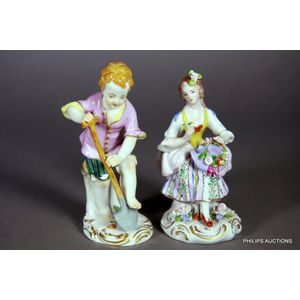Zeus Abducts Europa
You must be a subscriber, and be logged in to view price and dealer details.
Subscribe Now to view actual auction price for this item
When you subscribe, you have the option of setting the currency in which to display prices to $Au, $US, $NZ or Stg.
- Circa - A Latin term meaning 'about', often used in the antique trade to give an approximate date for the piece, usually considered to be five years on either side of the circa year. Thus, circa 1900 means the piece was made about 1900, probably between 1895 and 1905. The expression is sometimes abbreviated to c.1900.
- Floral Swag / Garland / Festoon - Floral swags are a decorative motif often used in the ornamentation of various objects, such as silverware, glassware, and furniture. The term "swag" refers to a garland or wreath of flowers, foliage, or other decorative elements, which is usually arranged in a loop or curve.
Floral swags can be found in a variety of decorative styles, from ornate Baroque and Rococo designs to more naturalistic Art Nouveau and Art Deco styles. They are often used to add a touch of elegance, refinement, or whimsy to an object, and can be seen on a range of items from chandeliers and candlesticks to picture frames and tea sets.
In the decoration of silver objects, floral swags are often used to accentuate the curves and lines of the piece, and to add visual interest to the surface. Similarly, on glass objects, floral swags may be used to frame or highlight a particular area of the object, or to add a touch of color and delicacy.
On furniture, floral swags can be found on a variety of pieces, from cabinets and armoires to chairs and sofas. They are often used to enhance the lines and curves of the furniture, and can be used to create a sense of movement and flow in the design.
Overall, floral swags are a versatile decorative element that can be adapted to a range of styles and applications, and have been used in the decoration of various objects throughout history.
This item has been included into following indexes:
Visually similar items

A Samson hard-paste porcelain figure of a flower-seller. 12 cm high.

Two porcelain polychrome figures: a Meissen Gardener and a Sitzendorf lady, 20th century, a gardener boy with a shovel, and a lady in eighteenth century country dress with a posy and a hat; both upon rococo bases; underglaze crossed swords and impressed nu

Three miniature figures, probably Derby, Chelsea, other, 18th to 19th century, a female figure in a white and yellow cape with highly coiffed hair, raised on a shallow white square base, in the manner of Derby; a figure of a Turk, bearing a Chelsea gold an

A female allegorical figure by Bow, circa 1760, the soft paste figure of a woman in flowing attire beside a floral encrusted urn and raised upon a moulded rococo style base, in soft pastel tones; with a square aperture to the reverse for a candlestick atta
